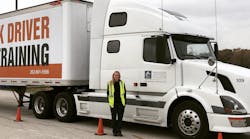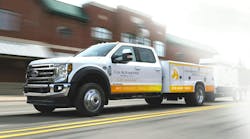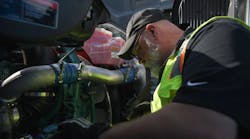While enrolled in Waukesha County Technical College’s professional truck driving program to obtain my Class A commercial driver’s license (CDL), I’ve been impressed with how thorough the instructors have been to educate incoming professional drivers for the trucking industry. Case in point, every student must learn how to conduct a complete pre-trip inspection.
During the second week of the 10-week program, we first learned about the process of how to inspect the tractor and trailer before we get behind the wheel.
Our instructor covered every area of the vehicle, beginning with the vehicle overview, the engine compartment, all sides of the tractor and trailer, the kingpin and fifth wheel and the cab. Not to mention, completing the LABS air brake test.
This introduction to the pre-trip inspection process took the class nearly two hours, going through every aspect of the vehicle. And that first walkaround was like drinking from a firehose.
As a new student, it may be overwhelming at the beginning. But, through formal training incoming drivers will have a comprehensive understanding of how to complete a pre-trip inspection.
While a real-life pre-trip should take a driver about 15 minutes, testing for the pre-trip inspection portion of the CDL test requires the driver to provide details on every aspect of the vehicle he or she is checking. The test can take about 45 minutes. Steps include pointing to each component or system of the vehicle, and stating out loud specifically what to look for to ensure there are no issues.
Since drivers should come with this prerequisite knowledge when they’re hired, that means they’re conducting a thorough pre-trip inspection every time they start their hours of service for the day, right?
This may not always be the case. Plus, for a driver who’s been behind the wheel for a number of years, a refresher on pre-trip may not hurt either.
A review of the vehicle
Pre-trip inspections are designed to catch issues before they become a threat to the safety of others on the road. Do you provide in-house training, refresher information or updates for drivers, or any other additional resources to help ensure they’re reviewing the vehicle on a regular basis?
Based on what I’ve studied for the formal pre-trip inspection exam, here are some areas you may consider for a pre-trip checklist:
Engine compartment and front of tractor. A review of all components under the hood, including the critical fluids - power steering, engine oil, coolant and windshield washer fluid, as well as components such as the water pump, air compressor, alternator, the power steering linkage, etc. The driver must also review all aspects of the steer axle, including the suspension (typically leaf springs), brakes and tires.
Tractor side and rear. This covers a review of the sides and back of the tractor, including air hoses, exhaust and the catwalk. This also includes examining one drive axle, including the suspension, brakes and tires.
Trailer side and rear. A review of the trailer header board, the back trailer doors and everything in between. This test also requires the review of one of the axles on the trailer tandems. Drivers must know how to inspect the suspension, brakes and tires.
Coupling device. While technically part of the tractor rear/trailer front inspection, the fifth wheel and kingpin have a separate checklist, which includes a review of the tractor portion (the fifth wheel/skid plate, slide locking pins and the pivot pin and release arm) as well as the trailer portion (the apron, or bottom of the trailer where the slide plate touches, and the king pin).
Cab check and engine start. The cab check should begin with a "safe start" - meaning before the vehicle is turned on, the driver must check to confirm the seat belt is in proper working order, and not frayed or damaged; the vehicle is in neutral (here, you can also check the throws to confirm the distance for shifting); that there is about 1-1/2 to 2" of free play on the clutch; and that the parking brake is on (the red and yellow knobs are pulled out). Once the vehicle is turned on, the driver will check the windshield wipers, all gauges are in proper working order, that the heat and defrost work and vehicle lights are all working. This includes headlights, high beams, turn signals, hazards, brake lights and clearance lights. This is also the time when you build air pressure for the air brakes, to complete the brake check.
Brake check. Drivers must have an understanding of the step-by-step process for ensuring all aspects of the air brake system are in proper working order. This is completed through the LABS test. LABS is an acronym which stands for leaks, alarms, buttons and service brake. The test takes less than five minutes, and allows drivers to confirm the air brake system is working properly before driving.
Safety equipment check. You must confirm the cab includes a full fire extinguisher, three safety triangles and electrical fuses.
This list might provide your team with some areas to consider when it comes to creating a pre-trip checklist for incoming drivers, or a refresher for long-time veterans behind the wheel.
Follow up with refreshers and training
A thorough pre-trip needs to be done at the start of duty for the driver, before he or she operates the vehicle. This isn’t to mention en route and post-trip inspections.
Driver vehicle inspection reports (DVIR) round out the pre-trip process, by alerting the maintenance staff to vehicle issues. A driver’s ability to provide accurate details are key for this report.
In class, it’s stressed that we don’t need to know what each component does, or how to fix it. But, it is critical that drivers be able to assess and report any issues as a preventive measure before it becomes critical or catastrophic.
Communication between drivers and maintenance is also important in order to ensure repairs and service are completed quickly and accurately. What type of process do you have in place to educate drivers on both the pre-trip process, and the completion of DVIRs?



